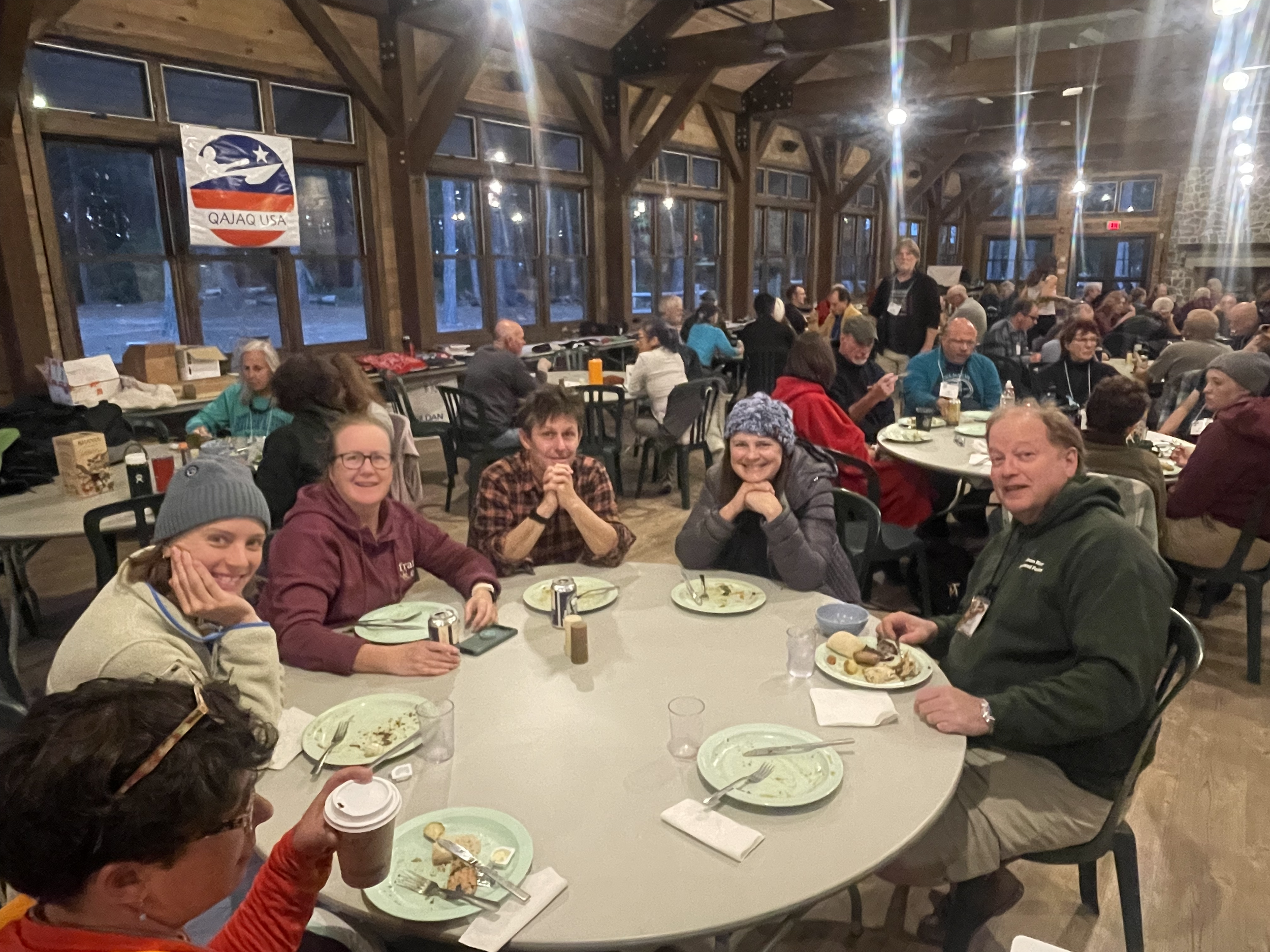Weekend at DelMarVa: by Christina Adamson
I haven’t left my apartment yet but I’m already questioning if this weekend will be more trouble than it’s worth. I should have been on the road by now, but a combination of running late at work and needing to pick up gear at Queens Landing has left me scrambling. By the time I reach Manhattan’s west side, I’m faced with a city’s worth of weekenders creeping toward the Holland Tunnel.
I trust not everyone is also headed to DelMarVa, the aquatic intersection between Delaware, Maryland and Virginia. And as time passes and traffic thins out, I close in on a campsite on Delaware’s South Inlet. Under a bridge and down an access road, I pull up to a somewhat rural RV park where I’m soon joined by Fiona and Alan, two of my companions from North Brooklyn Community Boathouse (NBCB). We hurry to set up camp against the wind and the dark, then chat logistics. We agree to leave early for Camp Arrowhead in the morning so there’s enough time to check-in and eat breakfast before the first day of programming. It’s getting late, but before retiring to my tent I turn off my headlamp and look at the stars. I don’t know where I am, but I can tell we’re close to the ocean from the smell and feel of the sand caught up in the breeze. The sun set before I made it out of New Jersey. I’ll have to wait for the morning to orient myself.
The next day comes and I’m still lost. My GPS insists “you’ve arrived!” but all I see is forest, marsh, and the sand swept road bending before me. I keep driving, almost missing the sign on my left.
At the west end of Angola Landing off Rehoboth Bay sits woody Camp Arrowhead. Home to the 35th annual DelMarVa Paddlers Retreat, a festival celebrating Greenland-style kayaking. This weekend it’s home to a handful of us from NBCB, along with about a hundred other paddlers from all over the world. I park and reunite with Fiona and Alan at registration. We soon meet up with other NBCB members Tania and Javier. Javier is a Greenland rolling connoisseur, and the trip leader at NBCB who suggested we participate in the festival. The dining hall is abuzz with Greenland enthusiasts; and each, old or new, brings an earnest passion and eagerness to teach and be taught. As I fill out a waiver, I hear the paddle carving workshop has been moved up to 8:00. I’m relieved I arrived early, and make my way to the Wright Pavilion.
One distinction between Greenland and European style kayaking are the paddles. Greenlanders use a thinner paddle where the blade contours naturally into the shoulders and shaft. A euro blade has the more common curved “power face” blades on both ends of the shaft. With all the detail and precision that go into Greenland paddles, I’m doubtful I’ll be able to carve my own from a block of wood in just two days. But our instructor Don Beale is confident everyone in our group will leave with a finished paddle, so we get to work. Don tells us he’s been crafting and selling custom paddles since 2002, but today is all about taking measurements and carving down our shape. I glean that it’s most important for the measurements to be equal on all sides of the paddle. What might not seem like a discrepancy now will matter very much during a long kayak trip. A sentiment that seems to be true universally across gear, equipment, and planning.
All of us craftspeople are working with red cedar. Combined with the wind blowing through the open air pavilion creates what I imagine a Norwegian spa would smell like, if not slightly smokey and salty. Unique to my block of wood is the spaced out grain running lengthwise, which Don excitedly tells me is a good thing. It means it will be lighter, sturdier, and perfect for rolling. At that mention, I’m snapped out of my wood-shaving-induced meditation and back to reality: that my goal at DelMarVa is to successfully roll a kayak. This was my intention when I registered a few months ago, and Javier keeps reminding me it’s “the whole reason you are here!” I’ve been trying to get my roll down for well over a year and am so bent out of shape over it, by the time I’m in the boat I actually feel nauseous.
Rolling a kayak is exactly what it sounds like. It’s being able to capsize and upright your boat without having to do a wet exit. There are over two dozen styles of rolling and I struggle to accomplish even one.
“The water is your friend!” shouts Javier wading out to meet me. “Ok!” I say. I think, or I know, at least that I love kayaking and want to be better at it. I like gliding through still water, paddling into waves, and am grateful that my organization in North Brooklyn has been such a steady presence in my life over the last few years. NBCB is a non-profit dedicated to connecting people to New York waterways, and a trip like this to DelMarVa is one of the many benefits. In the moment though, I’m not thinking about why I love kayaking and instead am trying to run down the clock here on the water. I do not get the roll on the first day. Although I feel relieved when I paddle back to shore, I know I still have Saturday to get through. I decide in advance to try a different boat.
I’ve never been in a traditional Greenland kayak, but the DelMarVa festival is accessible to novice kayakers because veteran paddlers share their boats with participants. These boats are different from the sea kayaks I’m used to in Brooklyn. The cockpit is smaller and more circular, some are even the traditional skin-on-frame. They are incredibly easy to roll, or capsize. I learn all of this and more at a lecture given by special guest Dr William Fitzhugh, director of the Smithsonian Arctic Studies Center and curator of the Department of Anthropology at the National Museum of Natural History. I’m awed but not surprised that the organizers have secured such a prominent guest; it speaks to DelMarVa as an institution with decades of influence and leadership in the Greenland community, not just an annual event. The evening wraps shortly after. Sunburnt and spent, myself and the crew from NBCB turn in to our cabins and tents. I stay up later, toiling over what Saturday will look like.
Mornings at DelMarVa start early with either yoga or functional training, followed by breakfast. I skip the 4 mile Indian River Life-Saving Station Tour, the all-day Cape Henlopen Open Water Trip and any classes like basic strokes, rescues, and rolling fundamentals. Instead I start the day with the second section of my paddle carving workshop. Maybe it’s the zeal from last night, or the camaraderie I feel with the other NBCB members, because as I sand down my paddle my mind wanders to rolling. I know the anxiety is all in my head, but what’s very real is the fear of wasting someone’s time. Like Javier’s or any of the other rolling mentors at DelMarVa, who would spend hours trying to help, all the while I couldn’t bother coming in with a good mindset in the first place. Letting them down sounds worse than rolling, to me.
At lunch, I open up about my new perspective with Fiona, Alan and Tania. I wished they were rolling with me this afternoon but have opted instead for a sculling workshop. So, I’m on my own back on the water, this time committed to a different boat that feels more snug and easier to move in. Off to a good start. My nerves are secondary to the absolute resolve I have to complete a roll. Javier isn’t out yet so I pair up with another mentor. We work on balance braces and easing into submersion. These baby steps help, and by the time Javier is in the water I am eager to show him my progress. But instead, Javier brings me back closer to shore, where the water is only a few inches deep. Here I work on refining my balance brace, and the snappy movement you have to make with your legs to upright the boat. There’s so much build up to the actual roll – the anticipation is the worst part – it helps to not think about it too hard. By the time we’re back in deeper water, I’m desperate to get the first attempt over with.
Being upside down in a boat underwater is straight up disorienting. None of the movements or exercises click, at least not right away, but I know I need to relax and trust where I am. Javier tells me I have to be like ~the snake~ wrap around my boat to build the momentum in order to flip back up, then find a balance brace and complete the roll. After a number of tries, the confusion slips away, nerves turn into motivation, and I finally complete my first Greenland roll. I’m thrilled but no one is happier for me than Javier. We spend at least another hour on the water workshopping and building muscle memory. I get a second roll, the butterfly, before I eventually run out of steam and return to shore. I bask in the afternoon sun and the relief of my accomplishment. I can’t wait to celebrate with Fiona, Alan, and Tania at dinner, and with the rest of NBCB later.
Early next morning, my time at DelMarVa is over. From under the same blanket of darkness of which I arrived I pack my gear and new paddle, only this time I know right where I am. Pulling out onto the sandy roads and away from camp, I have a long drive back with plenty of time to think. The talented Greenland paddlers I met at DelMarVa hold a commitment to passing down knowledge, spreading interest, and honoring history – what a special community. That was made clear from my first introduction, and reinforced with every encouraging word and detail at the festival. I feel immensely lucky to have NBCB waiting for me back in Brooklyn, where I can continue to practice, and hopefully pass on what I learned to someone else. One thing I don’t have to think about is if the drive, time, and energy are worth it – I already can’t wait for next year.
Published on Nov 6, 2024 by Admin.








